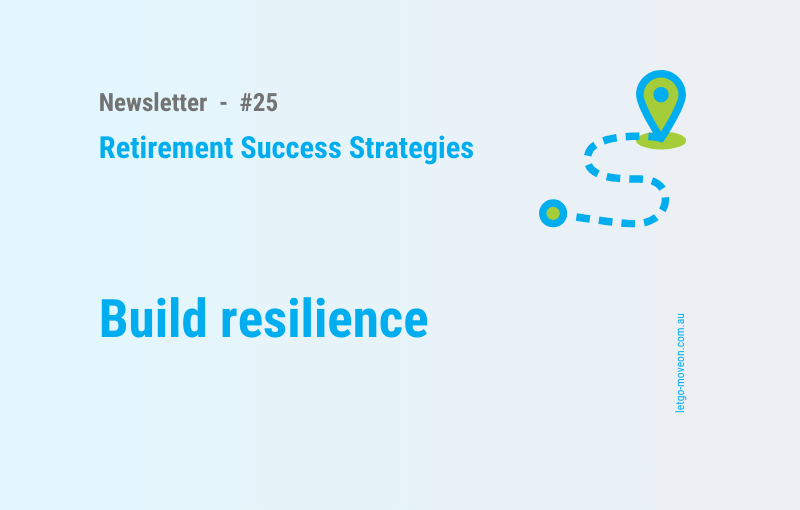Big goals often start with enthusiasm but can lose momentum when life gets busy or challenges arise.
Whether we decide to learn a new skill, declutter a space, improve our physical fitness, etc. – resilience is the key to staying on track.
Resilience isn’t about never struggling – it’s about continuing despite struggles and building confidence each time you overcome an obstacle.
Today, I want to discuss 5 practical steps that I learned during my coaching certification course at The Life Coach School that help us strengthen resilience.
I will provide two examples to illustrate how to apply these steps.
-
- Maria is learning a new language and
- Paul is tackling his long-term goal of clearing and cleaning the basement and attic.
Step 1: Define your “why” and make a strong commitment
Resilient people know exactly why their goal matters. A clear, personal reason fuels motivation when setbacks happen.
-
- Maria wants to learn Spanish to connect deeply with her grandchildren in Mexico. She writes: “I will hold a 10-minute conversation in Spanish with my grandchildren in 6 months.” To reinforce her commitment, she sets a reward: a family video call in Spanish as her milestone celebration.
- Paul’s basement and attic have been cluttered for years. His “why” isn’t just about tidiness – it’s about creating a safe, open space for a home workshop and freeing himself from the nagging stress of “someday I’ll get to it.” He commits: “I will have both spaces fully cleared and cleaned by October 1st.” His reward: setting up his dream woodworking area once the spaces are cleared.
Step 2: Clear away mental roadblocks
Distractions and doubts can quietly erode commitment. Spot them early and replace them with empowering actions.
-
- Maria notices her evenings vanish into TV and social media. She replaces this with a quick language habit: listening to a 5-minute Spanish podcast while cooking. She also considers how she can actively confront and overcome excuses:
Excuse: “I’m too tired.” → Counteraction: Review 10 flashcards before bed.
Excuse: “I don’t have time.” → Counteraction: Do a lesson while she is presents an opportunitycooking.
-
- Paul realises he’s been avoiding the basement because it feels overwhelming. He reframes the task into small chunks: “Today I’ll only sort one box.” For managing his excuses:
Excuse: “It’s too much; I’ll never finish.” → Counteraction: “I’ll set a timer for 15 minutes and stop when it rings.”
Excuse: “I don’t know where to start.” → Counteraction: “Start with the first box nearest the door.”
Step 3: Plan for moments you want to quit
The urge to quit often strikes in moments of frustration or fatigue. Anticipating it helps you stay the course.
-
- Maria creates a “rescue plan” for tough days: a bare-minimum activity like saying 3 Spanish sentences out loud or revisiting yesterday’s lesson for 5 minutes.
- Paul expects days when he won’t want to go near the clutter. His rescue plan: commit to carrying just one bag of trash or donation items out of the space. Even this small action keeps his momentum alive.
Step 4: Step into discomfort and take action
Growth requires embracing discomfort instead of avoiding it. Mistakes and mess are signs of progress.
-
- Maria doesn’t wait to feel “ready.” She starts speaking Spanish from day one by greeting a native speaker at her local café. She practices daily in small ways, focusing on communication over flawless grammar.
- Paul accepts the emotional discomfort of confronting sentimental clutter. Instead of aiming for perfection, he chooses “good enough” progress – he organises things roughly for now, knowing he can fine-tune later.
Step 5: Turn challenges into growth
Every obstacle presents an opportunity to build strength and skill. Resilient people reframe setbacks as stepping stones.
-
- When Maria struggles to understand fast Spanish conversations, she doesn’t give up. She replays sentences, notes down words to look up later, and celebrates small wins – like her first successful coffee order in Spanish.
- When Paul finds old items that stir up memories and slow his progress, he reframes this as an opportunity to strengthen his decision-making muscles. Each time he lets go of something, he builds confidence and emotional resilience. He celebrates when one corner of the basement is fully clear, giving him visible proof of progress.
Resilience is built one small choice at a time.
Give it a try!
Choose a goal that is important to you and develop your own action plan using the 5 steps:
-
- Step 1: Define your “why” and make a strong commitment.
- Step 2: Clear away mental roadblocks.
- Step 3: Plan for moments you want to quit.
- Step 4: Step into discomfort and take action.
- Step 5: Turn challenges into growth.
No matter how big or small your goal is, these steps can help you stay on track and build the resilience to see it through.

